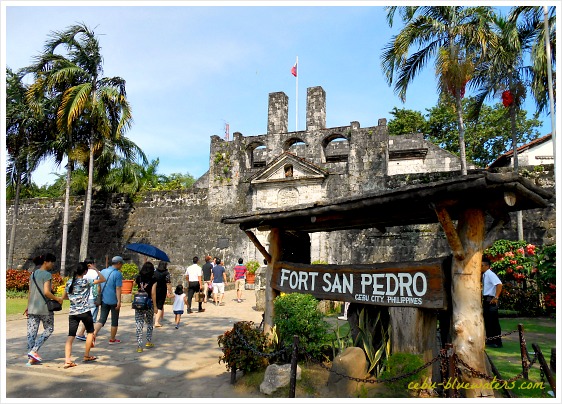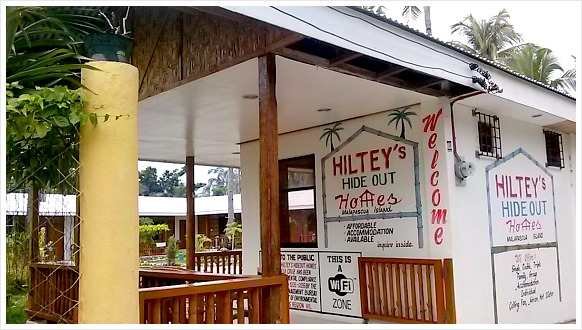Great Cebu Fort San Pedro...
Tells the Tale of Cebuanos' Struggle
Fort San Pedro, Cebu City
 Fort's entrance
Fort's entranceCebu Fort San Pedro
Fuerza de San Pedro or most commonly called Cebu Fort San Pedro, is a military defense structure that was built during the early times of the Spanish era in the 16th century.
This stone-walled fortress was built with barehands, sweat, and blood by Filipinos who were the supervision of their Spanish superiors. Although it bears the sad story of Cebuanos' past, it compensates the present Cebuanos by embracing their history and making use of this legacy as something positive...
 One of the three sides of the Cebu Fort San Pedro
One of the three sides of the Cebu Fort San PedroFortified Wall
It is considered as the oldest tri-bastion fort in the Philippines that was built in 1738 to keep the Spanish soldiers and other locals safe from the Muslim raiders.
It served as
the nucleus of the first Spanish settlers in the country.
By the end of the 19th century, Filipino revolutionaries used it as their stronghold.
The fort also served as the fortification of the Japanese soldiers during the World War II.
 Huge Spanish canon mounted on the top of the walls
Huge Spanish canon mounted on the top of the wallsA War Wall Turned Educational Wall
It also became part of the American Warwick Barracks during the American Regime. During this period, Filipino revolutionaries fought with the Americans against the invading Japanese troops on the island.
In later years, 1930’s to 1940’s, the barracks were renewed and have been turned into schools where Cebuanos started their formal education.
Army Camp Turned Mini Garden
Yet, during the World War II (1945) the fort served as an emergency hospital...
Later
than 1950, Fort San Pedro was an army camp till the Cebu Garden Club
took over and fixed the inner part and was later converted into a mini
garden. Some plants inside the fort came from Mexico which were brought by the Spaniards through their galleon ships.
 The inside of Fort San Pedro where visitors enjoy the historic walls.
The inside of Fort San Pedro where visitors enjoy the historic walls.The Fort's Structure
Its area is about 2,050 square meters; the walls are about 20 feet high, 8 feet thick and the towers are also about 30 feet high...
It has a triangular in shape, one facing at the City and the other two are facing toward the sea. It also has 14 mounted cannons, which are still in each respected places.
Hard Labor
The laborious construction began on the 8th of May 1565 by Miguel Lopez de Legazpi, the Spanish conquistador under the Spanish Government in Cebu.
Thus, outside the fort walls you can see the large statue of Miguel Lopez de Legazpi and Antonio Pigafetta with inscriptions of their work.
King Philip II's Information about the Fort
Fuerza San Pedro, the fort is described as built of stone mortar with a terraplein where guns are mounted. The fort contains the necessary buildings. The largest of these buildings was the "Cuerpo de Guardia" where the personnel that manned the fort lived. Adjacent to it was the "Vivende del Teniente" which was the living quarters of the lieutenant of the Fort. In between the aforementioned buildings is a well. At one corner attached to the walls of the bastion San Miguel (NE) was the "Alamazaros del Rivera" (powder magazine where the fort's supply or arms and gunpowder from Manila were stored).
The fort is now under the care and supervision of the City of Cebu, as a historical park. The land where it is located is owned by the Department of Environment and Natural Resources.

Where and what to find at Fort San Pedro
Fort San Pedro is located at Plaza Independencia, in the Pier Area of Cebu City. When you are already in the City, ask for any Jeepney that travels the Pier area, or take a taxi for a quicker ride to this Fort.
Nowadays, part of the fort is a museum where the Spanish documents, artifacts, sculptures, paintings, swords and other weaponry are being displayed.
The inside of the walls has been turned into a garden bedecked with some green and flowering tropical plants.
Thanks a lot for visiting and scanning the page.
Please, visit this free travel guide site more often to discover more destination guides or any nice vacation place you wish to be when on the island.
Have a great day!
Return to Landmarks Magellan Cross fromCebu Fort San Pedro
Return to Bluewaters Site Homepage from Cebu Fort San Pedro
Book Your Activity Here...
Please Like, Share...
Leave Messages...
|
|
Book & confirm your hotel room quickly and safely with Agoda Company. Agoda uses a state-of-the-art technology when processing your transaction online. Traveling Cebu is Agoda's official partner for eight years now. Find now your hotel here or below.




